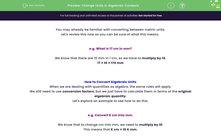You may already be familiar with converting between metric units.
Let's review this now so you can be sure of what this means.
e.g. What is 17 cm in mm?
We know that there are 10 mm in 1 cm, so we have to multiply by 10.
17 × 10 = 170 mm
How to Convert Algebraic Units
When we are dealing with quantities as algebra, the same rules will apply.
We still need to use conversion factors, but we just have to calculate them in terms of the original algebraic quantity.
Let's explore an example to see how to do this.
e.g. Convert K cm into mm.
We know that to change cm into mm, we need to multiply by 10.
This means that K cm = 10 K mm.
Makes sense, doesn't it?
Let's try another, more complex, example now.
e.g. Convert P m/s into km/h.
This is a two-step problem as we have two units of measurement present: distance (m/km) and time (s/h).
1) We know that there are 3600 seconds in 1 hour.
So P metres = 1 second
3600P metres = 1 hour
2) We know there are 1000 metres in a kilometre.
3600 P metres = 1 hour
3.6P km = 1 hour
Therefore, P m/s = 3.6P km/hr.
In this activity, you will practise converting algebraic amounts between different units by finding and applying one or more conversion factors.








